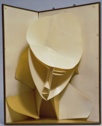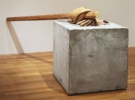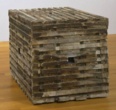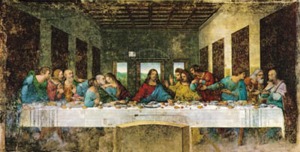
CCD array - Charge-coupled device array. Light-sensitive diodes used in scanners and digital cameras. These usually sweep across an image and, when exposed to light, generate a series of digital signals that are converted into pixel values.
CD-ROM - CD-ROM is an acronym which stands for compact disc read-only memory. A form of write-once, disc-based, random-access data storage, usually mass produced and distributed as a publication.
Also see new media.
CE or C.E. - Abbreviation for "Common Era," equivalent to AD, which stands for "Anno Domine" — Latin for "in the year of Our Lord." Unlike AD, but like BC and BCE, CE is conventionally placed after a number to show that it refers to a year counted as following the birth of Christ (even though contemporary experts generally agree that Christ was probably born in 3 or 4 BCE) CE is used to the same purpose as AD, and avoids a fully Christian bias. Although this system of numbering years is the globally dominant system, some cultures name years according to other schemes. Whereas 2007 is CE 2007, much of it is the year ____ in the Jewish calendar, ____ in the Islamic calendar, and the year of the ____ in the Chinese calendar, for instance.
Quotes:
Also see millennium.
cel - Short for cellophane. One of the principal media for film animation.
(pr. sell)
celadon - A ceramic glaze containing iron. It must be fired by the reduction method, with its red iron oxide (ferric) reduced to black (ferroso-ferric). The final color of the glaze is either olive green, gray-green, or gray. Celadon ware was developed and perfected during the prosperous Sung [or Song] dynasty (960-1279). It was valued by the Chinese largely because of its resemblance to jade.
(pr. SE-lə-dahn)
Examples:

China, Zhejiang province, probably the vicinity
of Shanglinhu, Bowl, Five
Dynasties period (907-960), 10th century, stoneware with carved
and incised design
under celadon glaze (Yue ware),
height 4 3/8 inches, Metropolitan Museum of Art, NY.

China, Vase with tubular ears, Southern
Song dynasty, Kuan ware, celadon glazed porcelain.

Korea, Openwork
Incense Burner, first half of the 12th century, celadon
glazed porcelain, height
15.3cm, National Museum of Korea. While fulfilling its function,
the design of
this incense burner juxtaposes
plant and animal motifs
with geometric openwork.
See Korean art.

Korea, Koryo Dynasty, three vessels, 13th century, celadon
glazed porcelain.
The pigment known as celadon green is also called green earth, the main ingredient of which is celadonite, an iron silicate. Chinese and Korean celadon porcelain was named for the resemblance of its color to this pigment. The word originated as the name of a character in the 1610 story by Frenchman Honoré d'Urfé, L'Astrée.
Also see Chinese art and Korean art.
cella - The main body or sanctuary of a classical temple, in which the cult statue usually stood. In Greek, naos.
(pr. SE-lə)
An example:
![]()

![]()
![]()
Greece, Didyma, Temple of Apollo, cella view,
marble, in the Ionic order, 60 x 118 m. See Apollo.
Also see Greek art, nave, pronaos, and sikhara.
cellocut
- In graphic arts, a plastic
plate — typically acetate, Lucite,
or Plexiglas. Or, a plastic
varnish used to add thickness
to or texture a design.
cellophane - A thin, flexible, transparent acetate film available in colorless as well as colored sheets and rolls. It is made from cellulose, generally obtained from wood pulp. Cellophane was originally a trademark, but is no longer.
(pr. SEL-ə-fayn)
Also see acrylics, cel, Lucite, packaging, plastics, PlexiGlas, polyethylene, and scissors.
celluclay - A comercially available material in powdered form, to be mixed with water, and used in making papier-mâché.
celluloid
- One of the earliest invented plastics,
celluloid is used for photographic
films. It is a cellulose nitrate which is tough and flammable,
generally obtained from wood pulp.
(pr. SEL-yə-loyd)
Examples of works incorporating celluloid:
Antoine Pevsner (French, born Russia, 1886-1962), Mask, 1923, celluloid and metal, 33 x 20 x 20 cm, Centre Georges Pompidou, Paris. See Constructivism.

Naum Gabo (worked in Germany, England, and
USA, born Russia, 1890-1977), Head of a Woman, c. 1917-20 (after a work of 1916), celluloid and metal, 24 1/2 x 19 1/4 x 14 inches (62.2 x 48.9 x 35.4 cm), Museum of Modern Art, NY.
cellulose - A substance obtained from plant cells, which is one of the basic materials used in the manufacture of plastics.
(pr. SEL-yə-lohs)
Examples of works in which cellulose was used:
Richard Hamilton (English, 1922-), Interior II, 1964, oil, cellulose paint and collage on board, 121.9 x 162.6 cm, Tate Gallery, London. See Pop Art.
Richard Hamilton, The Solomon R. Guggenheim (Neapolitan), 1965-6, fiberglass and cellulose relief, 121.9 x 121.9 x 17.8 cm, Tate Gallery, London.
trade names for cellulosics
|
trade name |
manufacturer, country |
| Bexoid ® (fiber) | BXL, UK |
| Cabulite ® (CAB) | May & Baker, UK |
| Celanese ® | Celenese Corp., USA |
| Celestoid ® | British Celenese, UK |
| Erinoid ® | Erinoid, UK |
| Lumarith ® | Celenese Corp., USA |
| Tenite ® | Eastman Chemicals, USA |
See trademark (®).
Celsius - A temperature scale on which the freezing point of water is 0°, and the boiling point of water is 100° under normal atmospheric pressure (after Anders Celsius.) It is the equivalent to Centigrade. Abbreviated C.
(pr. SEL-see-əs)
cement - A powdered substance made by grinding calcined limestone and clay, which can be mixed with water and poured to set as a solid mass or used as a binding ingredient in mortar or concrete. Sometimes called Portland cement after an important early site of its manufacture.
(pr. sə-MENT)
|
All dusts are A user should wear an appropriate dust-mask and eye protection, or be very effective in preventing dust from damaging the workplace's atmosphere. |
Examples of sculptures using cement:
Pierre-Auguste Renoir (French, 1841-1919), Bust of Madame Renoir, 1916, polychromed cement, Musée d'Orsay, Paris.

Giovanni Anselmo (Italian, 1934-), Torsion, 1968, cement, leather, and wood, 52 inches x 9 feet 5 inches x 58 inches (132.1 x 287 x 147.3 cm), Museum of Modern Art, NY.

Jackie Winsor (American, born Canada, 1941-), Burnt Piece, 1977-78, cement, burnt wood and wire mesh, 33 7/8 x 34 x 34 inches (86.1 x 86.4 x 86.4 cm), Museum of Modern Art, NY.
Cement may also refer to substances that harden to act as an adhesive; glue, or to glue.
(pr. sə-MENT)
Also see aggregate, plaster, sand, and stain and stain removal.
cenacle or cenacolo - A cenacle is a painting of the last supper — Christ dining with his disciples the night before he was crucified. Cenacolo is the Italian equivalent often used by English speakers.
(pr. SEN-ə-kəl, sə-NOK-ə-loh)
Examples:

Leonardo da Vinci (Italian, 1452-1519), The
Last Supper, 1498, modified fresco, 15 x 29 feet (460 x 880 cm), Convent
of Santa Maria delle Grazie (Refectory), Milan. See focal
point, Renaissance, and
symmetry.
Salvador Dalí (Spanish, 1904-1988), Last Supper, 1955, National Gallery, Washington, DC. See Surrealism.
censorship, censor, censure, censorious
- Censorship is the act or process
of  examining
and removing obscene or otherwise
objectionable material; the
act of expurgating. A censor is a person who examines and removes
such material. To censor is to examine and remove such material.
To censure is to criticise severely; to blame. A censure is an
expression of disapproval,
blame, or criticism, which may be an official declaration of such
disapproval. Censorious describes the tendency to censure.
examining
and removing obscene or otherwise
objectionable material; the
act of expurgating. A censor is a person who examines and removes
such material. To censor is to examine and remove such material.
To censure is to criticise severely; to blame. A censure is an
expression of disapproval,
blame, or criticism, which may be an official declaration of such
disapproval. Censorious describes the tendency to censure.
Quote:
Other resources on censorship:
Also see aniconic, art criticism, degenerate, erotica and erotic art, fascist aesthetic, feminism and feminist art, fig leaf, First Amendment rights, gymnophobia, iconoclast, iconomachy, iconophobia, iconophobiac, iconophobic, New Deal art, nude, placeholder, political correctness, pornography, and xenophobia.
![]()

![]() Center for Arts and Culture - The Center for Arts and Culture is an independent American think tank which aims to inform and improve policy decisions that affect cultural life. The guiding principles of that mission include freedom of imagination, inquiry and expression, as well as freedom of opportunity for all to participate in a vital and diverse culture.
Center for Arts and Culture - The Center for Arts and Culture is an independent American think tank which aims to inform and improve policy decisions that affect cultural life. The guiding principles of that mission include freedom of imagination, inquiry and expression, as well as freedom of opportunity for all to participate in a vital and diverse culture.
Founded in 1994 in Washington, DC, the Center is a nonprofit, non-partisan organization, supported by foundations and individuals, governed by a board of directors, and advised by a Research Advisory Council. It is affiliated with George Mason University, Arlington, Virginia. The Center commissions research, holds public roundtables, and publishes new voices and perspectives on the arts and culture.
The Center's website provides discussion of current issues in cultural policy — policies concerning cultural law, globalization, access, preservation, community, investment, and education — some bibliographic resources, and contact information for related professionals and organizations. Its Cultural Commons listserv is well known among academics and policy analysts, particularly those working on cultural diplomacy, creative economy, and intellectual property. The website also maintains updates on judicial and legislative action on the federal level.
Also see artists' organizations, and First Amendment rights.
centering - In architecture, a wooden framework to support an arch or a vault during its construction. In pottery, the process of controlling the position of the clay as it spins on a potter's wheel, so that, however its form is altered, the clay at every level is made to be the same distance from the axis of the spin. In digital imaging, positioning an image properly within the digital field of vision, so that it is framed appropriately.
center of gravity - The point of rest or balance.
Centigrade - A temperature scale on which the freezing point of water is 0°, and the boiling point of water is 100° under normal atmospheric pressure. It is the equivalent to Celsius (after Anders Celsius.) Abbreviated C.
centimeter - A unit of distance measurement equal to 1/100 of a meter, or to 10 millimeters. To convert centimeters into feet, multiply them by 0.03281; to inches, x 0.3937. To convert cubic centimeters into cubic inches, multiply them by 0.06102; into pints (US liquid), x 0.00211. Abbreviated cm.
Also see angstrom.
central plan - In architecture, a plan in which the parts of a building radiate from a central point.
Also see axial plan, cathedral, and square schematization.
centrifugal casting - A means of casting employing the force achieved in a spinning apparatus to push the casting material into a mold. (Refers to centrifugal force — moving away from an axis; the opposite being centripetal force — moving toward an axis.)
ceramist - A person who makes ceramics.
(pr. SEH-rə-mist)
Also see art careers.
Cercle et Carré - French for "circle and square." A group of painters who came together in 1929.
cerulean blue - A particular blue pigment.
Related resource:
CGM - Computer Graphics Metafile. In digital
imaging, an image-file format designed to handle a wide range
of image types, but currently used primarily for vector
graphics.
https://inform.quest/_art